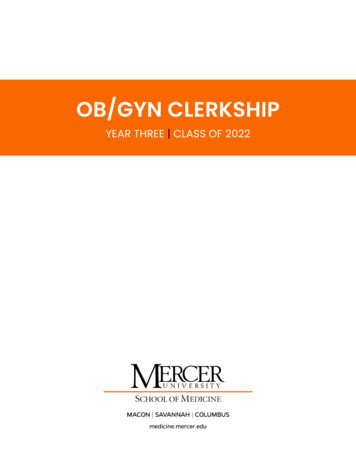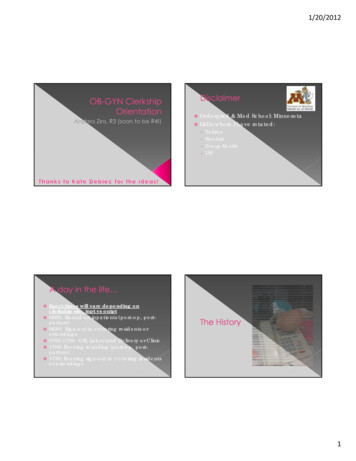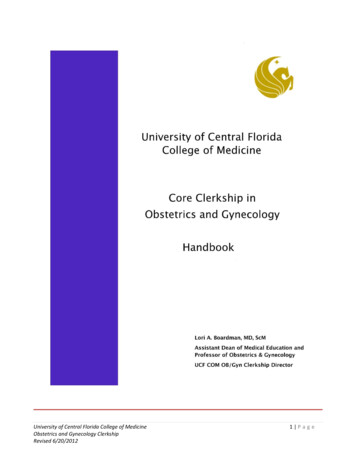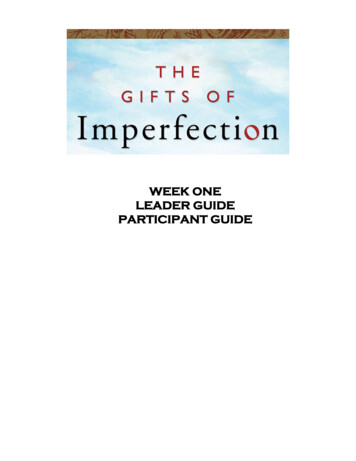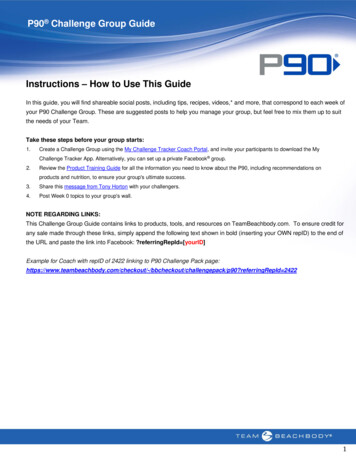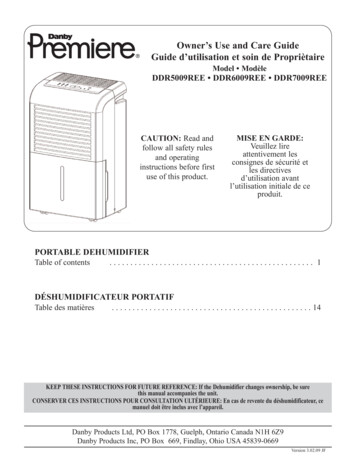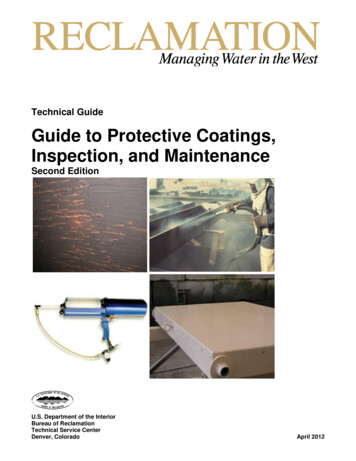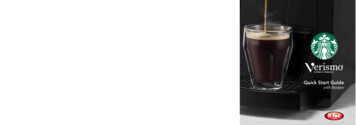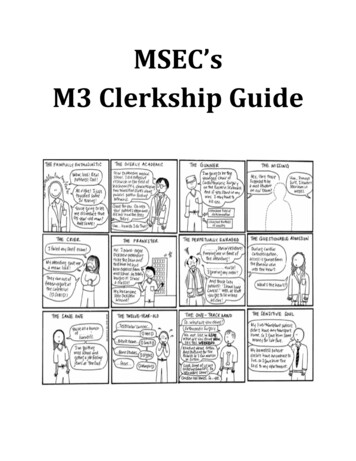
Transcription
MSEC’sM3 Clerkship Guide
MSEC’sM3 Clerkship GuideHey rising M3s! Along with the help of many from the classes before usand members of the Class of 2019, MSEC has put together this M3 clerkshipguide to help you prepare for your upcoming clinical rotations. All of theinformation in this packet is from students, although much of it has beenreviewed by faculty as well. Our aim is to help decrease anxiety and make thetransition to third year easier. You’ve mastered how to sit in a classroom andtake tests. Now the fun begins! You will learn to interact with patients, gatherdata and use all the information you learned in your M1 and M2 years to treatpatients. Hopefully, this guide will help you become the best clerkshipstudents possible!Editors: Megan Goss, Shelby Lane, Peter Ketch, Ryker SaundersIllustrations:Michelle Au: specialtystereotypes.htmlElena Welt: 02/med-studentstereotypes-1.htmlDisclaimer: All of the information in this packet came from students’experiences on the clerkships since 2013. All information is subject to change.Please see the clerkship orientation information for the most updatedinformation.2
Table of Contents:1.2.3.4.5.6.Getting Started:a. What To Keep In Your White Coat Pockets 4b. What Not to Wear (and what to wear) .5c. Note Writing .6d. Student Health .7e. Shelf Study Guide 8f. Absentee Policy .15Memphis Clerkships . 17a. Internal Medicine .18b. Pediatrics .23c. Obstetrics and Gynecology .27d. Family Medicine 36i.Murfreesboro Family Medicine .38e. Psychiatry . .41f. Neurology . .45g. Surgery .49Chattanooga Clerkships 59a. Internal Medicine .60b. Pediatrics .64c. Obstetrics and Gynecology .68d. Family Medicine 71e. Psychiatry . .73f. Neurology . .75g. Surgery . .78Knoxville Clerkships . 82a. Internal Medicine . .83b. Obstetrics and Gynecology . .85c. Family Medicine .88d. Psychiatry .90e. Neurology . .92f. Surgery . .94Nashville Clerkships .97a. Internal Medicine .98Housing . . .1003
What to Keep in Your White Coat Pockets1. Pens: Keep 2-3 pens with you. Attendings and residents often need toborrow them and the pens can disappear quickly.2. Pen light4. Stethoscope5. Pocket reference guides:Pocket Medicine, Maxwells, etc.6. Reflex Hammer and traumashears (bandage scissors).Not necessary for everyrotation, but good, useful toolsto have if you think there is achance you may need them.7. Small notebook8. A snack: Rounds can be longand it’s a good idea to keep anemergency protein bar orgranola bar9. Medications: get a smallcontainer and put any neededmeds (Advil, Tylenol, Tums,allergy pills, migraine meds, anti-anxieties, anti-diarrheals, etc). You neverknow when you’ll need something. Also good idea to keep inhalers andEpiPens in there if you need them.10. Hand sanitizer4
What Not To Wear (& what you should wear)In general, you either wear scrubs or business attire. You will wear your white coat overwhat you wear on almost every rotation (for some aspects of surgery and in L&D, you don’thave to wear it at all times). Here are some gender specific suggestions for the businessattire:Guys:Dress pants and a button down shirt are acceptable on most rotations. You don’t have towear a blazer/sport coat-your white coat takes the place of that. You need to wear a tie ifyour attending wears one. So it is a good rule of thumb to wear a tie until you figure out ifyour attending does. When buying new dress clothes, look for no-iron items so your drycleaning bill isn’t outrageous and so you don’t have to iron. Brooks Brothers and BananaRepublic have great lines of no-iron button down shirts and pants. Wear comfortable dressshoes.Ladies:Dress pants and a nice shirt are acceptable for girls as well. Skirts and dresses can be wornas long as they are knee length. Hospital rules require that pantyhose or tights be wornwith skirts and dresses. Make sure tops are conservative and don’t show toomuch anything. When trying on shirts/skirts, pretend to bend over a hospital bed andmake sure they aren’t too revealing. Also, only wear close-toed shoes. Try to find clothesthat don’t have to be dry-cleaned. Look for sales at places like Ann Taylor, Ann Taylor Loft,TJ Maxx, Gap, and Banana Republic for professionalitems at discounted prices. Remember you are going tobe in a hospital around bodily fluids;therefore, do not wear your nicest clothing. Also, don’twear any valuable jewelry that could get lost duringhandwashing or scrubbing.Scrubs:Scrubs are worn on most surgical rotations. Where youcan obtain them will be discussed later in this guide.Make sure to wear comfortable shoes. Tennis shoes areacceptable when you wear scrubs. Another popularshoe is Danskos for both guys and ladies. They usuallyrun 125- 150. They are somewhat uncomfortableand hard at first, but are great once they are broken in.Make sure you have shoes that provide good supportsince you will be standing for hours.5
Writing Notes:As a medical student, you will either write notes in the chart or computer notes for thepatients you are following. You will write a history and physical on all new patients youwork up (and consults) and a SOAP note on the patients each morning. A SOAP note is thesame thing as a Progress Note. You should develop your own system so that you canremember it each time. Each attending may want your notes a little different, so just tailoryour H&Ps and SOAP notes to the attending’s desired format. Also, different items areincluded for different rotations, ex. OB and psych have different formats, but they will teachyou on the rotation. Here is an example of what should be included in the notes.History and PhysicalDate/TimeChief Complaint: why is the patient at the hospital/clinicHistory of Present Illness: Timing, duration of symptoms, exacerbating and relievingfactors, location, setting, severity (on a scale from 1-10), quality (describe the symptom),associated symptoms,Past Medical History: Things patients have been treated for in the pastPast Surgical History: Any previous surgeriesFamily History: Diseases that run the familySocial History: tobacco (always get pack years), alcohol (always ask CAGE Qs), illegaldrugs, education, and employmentAllergies: Drug allergies and other allergiesMedications: Current medications, dose, rout, and scheduleReview of Systems:Physical Exam: Includes general appearance, vital signs, and all body systemsLabs: use skeletons found in Maxwells for CBC/ CMP/electrolyte/coagsRadiology:Assessment: Age, gender, race, what they are admitted for, likely diagnosis, prognosis,current conditionPlan: What are you going to do for each diagnosis. Include DVT prophylaxis and GIprophylaxis if needed.Signature: John Doe, M3SOAP Note (M3 Progress Note)Date/TimeSubjective: What the patient tells you (or family/nursing if patient can’t talk)Objective: Vital signs, Ins and Outs (I/O) physical exam, labs, radiologyAssessment: Age, gender, race, what they are admitted for, likely diagnosis, prognosis,current conditionPlan: What are you going to do for each diagnosis. Include DVT prophylaxis and GIprophylaxis if needed.Signature: Jane Doe, M36
Student Health Information1. Memphisa. UTHSC Student Health 24/7 on-call provider for urgent issues: 901-5415654b. UHS: M-F 8:00am-5:00pm. Closed daily between 1:00pm and 2:00pm; makeappt 901-448-5630c. Mental health concerns on/off campus: SAP (Student Assistance Program) 1800-327-2255. Providers are available nationwide, allows face-to-faceappointments or by telephone, at no cost to you.2. Knoxville: Students may go to UTK Student Health Service for medical care and/orbehavioral health care. They are to state that they are a UTHSC student and any feeshould be billed to UT Health Science Centera. UTK Student Health: 865-974-3648b. UTK Counseling Center: 865-974-22513. Nashville: For the time being, special arrangements have been made to providestudents access to Vanderbilt Student Health Center for medical care and urgentbehavioral health carea. Vanderbilt Student Health Center: 615-322-2427 to make an apptb. For behavioral health counseling, contact SAP (Student Assistance Program)1-800-327-2255. Providers are available nationwide, allows face-to-faceappointments or by telephone, at no cost to you.c. For problems encountered while at Vanderbilt, contact Jennifer Swails at615-343-40834. Chattanooga: Students may to go UTC University Health Services for medical careand/or behavioral health care. All services are filed on your insurance. Students mayreceive behavioral health counseling at NO charge through SAPa. Medical Office Supervisor: Henrietta Gilbert at 423-425-9378b. If problems arise, contact UTC University Health Services campus rep: NancyBadger at 423-425-5329c. Appointment Desk: 423-778-9303d. Nurse Line: 423-778-9336e. UTC Counseling and Personal Development: 423-425-44385. Questions? www.uthsc.edu/univheal or call Christa Deiss at 901-448-50647
Shelf Exam Study GuideDisclaimer:This is not an all-inclusive 100% sure-fire guide to “acing” the shelf exams. However, it isbased off a guide passed down by a previous UTHSC student George Cibulas that manystudents relied heavily on throughout M3 year. The resources are listed in an order ofrecommendation based on the opinions of those who have written and edited this guide inthe past. Student opinions will vary and we highly recommend talking to students in theclass above you. It is extremely wise to take practice NBMEs for each clerkship youare on (especially for your first one). You will most likely see 3-5 questions from theNBMEs on your actual SHELF.Also, OnlineMedEd is a fantastic online resource that is highly recommended for allclerkships, especially Internal Medicine and Surgery. They are quick 20min videoswith great summaries, simple problem solving algorithms, and test taking strategies.Ob-Gyn:1. About the Shelf:a. This exam is curved. You can expect between 5-10 points.2. Resources:a. Casefiles- read cover to cover. Arguably the best Casefiles series.b. ACOG questions: https://www.apgo.org/student/uwise2.htmlc. Practice NBMEs: https://nsas.nbme.org/homed. uWorld Questions8
Medicine:1. About the Shelf:a. This exam is NOT curved. Minimum raw score of 80 to be eligible for an A.2. Resources:a. uWorld Questions ALL 1400-1500 or so of them.b. Internal Medicine Clerkship Review from Univ. of Texas San dyear.aspi. You will see there are clerkship reviews for pediatrics, psychiatry, andsurgery as well. Make sure to download and print out the PDF so youcan take notes as you watch the podcast. Your annotated notes willmake a great “night before” refresher.c. Practice NBMEs: https://nsas.nbme.org/homed. MKSAP 5 Review Book: did these questions after uWorld to reinforce bigtopics (Cardiology, Pulm, Infectious disease, etc)e. Casefiles Medicine: If it works for you and you can burn through it, it won’thurt9
Surgery:1. About this Shelf:a. Cutoff to get an A is an 81 (yes, an 81). This exam is curved. Max curve 10pts. Min curve 2-3 points. There is no curve on the oral exams. Your bestprep is to do the medicine clerkship before surgery, because there is a lot ofmedicine on this one.2. Resources:a. Pestana Notes (Book AND PDF). I thought this was an excellent resource. It’squick though, and you’ll probably finish and wonder “What else should Iread?”i. Stick this in your back scrub pocket and read it during down time.ii. PDF: http://www.uky.edu/ amwill7/Pestana%20SURGERY%20REVIEW.pdf1. PDF of questions (including some that are not in the book).b. DiVirgilio's Surgery: A Case-Based Clinical Review. It's basically a morefleshed-out version of Pestana & a quick, well organized review.c. Surgery Clerkship Review from Univ. of Texas San Antoniod. uWorld Surgery questionse. Practice NBMEs: https://nsas.nbme.org/homef. NMS Surgery Casebook (smaller): This is pretty much the standard “text” thateveryone reads for surgery.g. NMS Surgery Textbook (bigger): People who scored highest in my block usedthis resource and apparently there are questions in it as well.h.**Recall Surgery- This book really doesn’t have much yield for the shelf exams, but itis helpful for your day-to-day pimp questions. Basically, it will make you look smartin the OR (at least not dumb).Surgery Oral Exams: Can be pretty nerve-racking, but no need. Just pay attentionwhile you’re on the rotation, study for the shelf exam, and you’ll be fine. Mosteveryone gets around a 90 on this if your thoughts are coherent and your logic issound. Expect common things. Wear professional dress (no scrubs).10
Psychiatry:1. About this Shelf:a. Remember the block is only 4 weeks long. There is no curve. Cutoff for an “A”is 80. While many people say this SHELF is “easy,” don’t slack off on studying.All SHELF exams require a good amount of studying to do well.2. Resources:a. First Aid for the Psychiatry Clerkship: read this cover-to-cover.b. Psychiatry Clerkship Review from Univ. of Texas San Antonioc. Lange Q&A Psychiatry (10th Ed): This was just more questions in order toget some more practice.d. Practice NBMEs: https://nsas.nbme.org/homee. Casefiles Psychiatry: Use the questions at the end of each chapter instead ofreading this one cover t
This is not an all-inclusive 100% sure-fire guide to “acing” the shelf exams. However, it is based off a guide passed down by a previous UTHSC student George Cibulas that many students relied heavily on throughout M3 year. The resources are listed in an order of recommendation based on the opinions of those who have written and edited this guide in the past. Student opinions will vary and .
